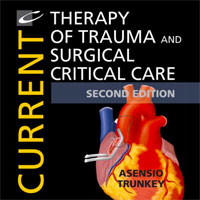Tag: trauma
Serum Lactate Upon Emergency Department Arrival as Predictor of 30-day In-Hospital Mortality
Despite of numerous evidences that elevated serum lactate levels were associated with unfavorable outcomes, there have been no study demonstrated an optimal cutoff of serum lactate in unselected patients. This study was aimed... read more
Patient Experiences of Trauma Resuscitation
In this qualitative study that included semistructured interviews and video observations of trauma resuscitation, patients drew satisfaction from trauma team members' demeanor, expertise, and efficiency and valued clear... read more
Development and Validation of an Empiric Tool to Predict Favorable Neurologic Outcomes Among PICU Patients
This proposed prediction tool encompasses 20 risk factors into one probability to predict favorable neurologic outcome during ICU stay among children with critical illness. Future studies should seek external validation and... read more
Current Therapy of Trauma and Surgical Critical Care
A comprehensive and contemporary summary of the treatment and post-operative management of traumatic injuries. The concise format makes it ideally suited for everyday use, and new, full-color illustrations highlight the most... read more

Guidelines for the Diagnosis and Management of Critical Illness-Related Corticosteroid Insufficiency – Part II
This part II of the guidelines for the diagnosis and management of critical illness-related corticosteroid insufficiency (CIRCI) in critically ill patients is related to acute illnesses that may be complicated by CIRCI. We... read more
Alleviating ICU Survivors’ Burden
In a review paper, a team of international researchers highlights how critical illness and critical care affect longer-term outcomes. According to the authors, the severity of acute illness determines the degree of impairment... read more
What Can Psychologists Do in Intensive Care?
As awareness has grown of the great distress intensive care patients may suffer, units have begun recruiting psychologists to their teams. Intensive care unit psychologists aim to assess and reduce distress for patients,... read more
We Need to Talk About Trauma
One of the most haunting images from my time as a junior doctor working in Hackney in the mid-1990s was in an A&E (emergency) department while we tried to resuscitate a man in his 40s. In the corner of the room stood two... read more
The Nurses: A Year of Secrets, Drama, and Miracles with the Heroes of the Hospital
Nurses is the compelling story of the year in the life of four nurses, and the drama, unsung heroism, and unique sisterhood of nursing—one of the world's most important professions (nurses save lives every day), and one... read more

Mountain Ultra-Marathon Finishers Exhibit Marked Immune Alterations Similar to Those of Severe Trauma Patients
Runners competing in mountain ultra-marathons (MUMs) are known to display features of marked inflammation due to muscle micro-trauma, oxidative stress, gastrointestinal dysfunction, or endotoxin translocation. Furthermore,... read more
Late Mortality After AHRF
Acute hypoxic respiratory failure (AHRF) is associated with significant acute mortality. It is unclear whether later mortality is predominantly driven by pre-existing comorbid disease, the acute inciting event or is the result... read more
The Impact of Mean Arterial Pressure on Functional Outcome Post Trauma-Related Acute Spinal Cord Injury
Although no definitive conclusions could be reached based on the data collected, this study does give valuable insight into future avenues of research on the topic of hemodynamic management in traumatic ASCI as well as provides... read more
The 10 False Beliefs in Adult Critical Care Nephrology
Acute tubular necrosis (ATN), a histological pattern observed after ischemic insult, is considered the most frequent cause of any form of acute kidney injury (AKI) despite the absence of extensive histological data. This... read more
Prehospital Antibiotics in the Ambulance for Sepsis
Emergency medical services (EMS) personnel have already made substantial contributions to improving care for patients with time-dependent illnesses, such as trauma and myocardial infarction. Patients with sepsis could also... read more
The Prognostic Value of MRI in Moderate and Severe TBI
Traumatic brain injury (TBI) is a major cause of death and disability, yet many predictors of outcome are not precise enough to guide initial clinical decision-making. Although increasingly used in the early phase following... read more
Hypoxia and Hypotension in Patients Intubated by Physician Staffed Helicopter EMS
The effective treatment of airway compromise in trauma and non-trauma patients is important. Hypoxia and hypotension are predictors of negative patient outcomes and increased mortality, and may be important quality indicators... read more
The Quiet Room
The grim reality for trauma healthcare clinicians. From the vantage point of a trauma surgeon, conversation seems a terribly feeble response. Gun violence, whether on the streets of Chicago or in the churches of Charleston... read more
The Dark Sides of Fluid Administration in the Critically Ill Patient
The administration of intravenous fluids is probably the most frequently initiated therapy in critically ill patients. With very few exceptions, such as severe congestive heart failure, IV fluids are considered as a safe... read more
Predicting outcomes after trauma to the brain
UMMS researchers help develop novel tool to predict survival after penetrating brain injury. Using the new tool they developed, the SPIN-Score (Surviving Penetrating Injury to the Brain), two factors were by far the strongest... read more
Effect of treatment delay on the effectiveness and safety of antifibrinolytics in acute severe hemorrhage
Antifibrinolytics reduce death from bleeding in trauma and post-partum haemorrhage. We examined the effect of treatment delay on the effectiveness of antifibrinolytics. We obtained data for 40,138 patients from two randomised... read more
Shock Trauma to Study Body Cooling for Patients in Cardiac Arrest from Massive Bleeding
The R Adams Cowley Shock Trauma Center at the University of Maryland has opened a clinical trial to study whether rapidly cooling the body temperature of patients whose hearts stop due to massive blood loss will give surgeons... read more
Rapid Retriage of Critically Injured Trauma Patients
Critically injured patients presenting to nontrauma hospitals require timely transfer to trauma centers; however, the transfer process varies and differences in outcomes for patients from trauma centers are unknown. We evaluated... read more









